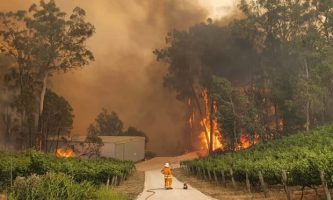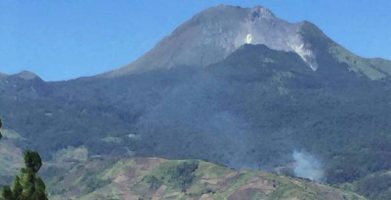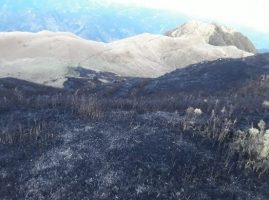A few months away from the start of a new decade, a wildfire started to raze the
northern part of Australia in September 2019. Today, it is now considered as one of
the most destructive bushfires that has ever hit Australia with more than 20 related
deaths and 1,300 houses destroyed, mainly in New South Wales.
Why do bushfires occur?
Summer in Australia is also known as fire season, which is associated with hot and
dry weather making it easier for blazes to start and spread.
There are different reasons why bushfires occur. Natural causes happen when
lightning strikes drought-affected forests. Another reason may be arson, which is
manmade.
In Australia’s case, strong winds made the fires and smoke spread rapidly. The
Climate Council stated that climate change has worsened the impact and intensity of
natural disasters, as in the case of Australia’s bushfires.
As of January 6, 2020, more than 5.9 million hectares have been burned across
Australia’s six states. The worst affected state is New South Wales with 3.6 million
hectares burned.
It also brought massive destruction in Australia’s wildlife and environment.
According to Federal Environment Minister Sussan Ley, a third of the koalas’
population in New South Wales have been killed in their habitat due to the fires.

The Difference between Wildfire and Bushfires
While a bushfire is a large fire in vegetation dominated by shrubs like grasses and
herbs, a wildfire is a rapidly-spreading fire occurring in a wild land area or
unoccupied land.
Wildfires in the Philippines
One of the notable wildfire incidents that struck the Philippines happened during
the hot and humid day of March 26, 2016. The fire was believed to have been caused
by a campfire setup by local tourists in Mount Apo in Davao City. The fire lasted for
weeks until April. Because of this, Mt. Apo was off-limits for months to allow its
vegetation to regenerate.

The Department of Environment and Natural Resources (DENR) and local
authorities saw this as an opportunity to strengthen the protection of the natural
state of Mt. Apo.
Another incident is the Mt. Pulag fire last January 20, 2018. Seven hikers caused a
grass fire that damaged about 6 hectares of the protected national park in Benguet.
According to DENR Secretary Roy Cimatu, the fire might have been set accidentally
with the wind helping spread the fire.

The acting legal head of DENR Cordillera, Rainier Laita, stated that the estimated
cost of the Mt. Pulag fire is P2.3 million. In compliance with the Forest Code of the
Philippines, the person who started the fire and allowed it to spread should pay 8
times the cost, and be imprisoned for less than 6 years.
These two notable wildfire incidents in the Philippines are both manmade. Although
the protected areas may regenerate in time, these incidents still brought massive
destruction to the preserved spots in the country—permanent damage that can be
prevented. These prove that neglect and irresponsible behavior could cause massive
environmental degradation.
From weather and the environment, to disaster preparedness and climate change, 2017 has been a year of changes and adaptation. As we welcome the New Year, let’s look back at past issues which have helped shape the future.
WEATHER AND CLIMATE
PAGASA began using impact-based weather forecasting this year, wherein apart from forecasting weather conditions, effects of weather disturbances are also explained. This emphasizes the effects of a hazard rather than merely identifying it. Impact-based forecasting and warning services focus on translating meteorological and hydrological hazards into specific impacts, and the development of responses to mitigate such impacts. This year, 22 tropical cyclones visited the Philippines with the last two as the most devastating.

On December 13, the Low Pressure Area in Surigao del Sur intensified into a Tropical Depression and was named Urduja. Three days later, it made landfall in Eastern Samar, and continued to traverse Masbate, Sibuyan and Cuyo Islands and Taytay, Palawan. According to the National Disaster Risk Reduction and Management Council (NDRRMC), 1.8 million individuals were displaced by “Urduja,” while 47 perished. Right after “Urduja” exited the Philippine Area of Responsibility (PAR), Tropical Depression Vinta took over. Heavy rains from the storm inundated parts of Visayas and Mindanao where flash floods and landslides occurred. On December 22 and 23, the storm hit Cateel, Davao Oriental and Balabac, Palawan respectively. 720,000 were displaced, while 163 were reported dead.

In the last quarter of the year, PAGASA warned Filipinos to prepare for a developing La Niña, a weather phenomenon characterized by above-normal rainfall, colder temperatures and stronger winds from the east. According to the Climate Information Monitoring and Prediction Section of the weather bureau, the La Niña is not expected to last beyond March 2018 but the public is still alerted against possible effects.

Abroad, Hurricane Harvey swept through Texas in August where it killed 82 people and dumped 51 inches of rain, the greatest amount ever recorded from a single storm in the continental United States. In September, Hurricane Irma left a trail of destruction, taking 69 lives and displacing 1.2 million people in the Caribbean. Hurricane Maria struck in Dominca and Puerto Rico lastmonth, causing more than 1,000 deaths. Heavy rains also crippled Bangladesh, China, Hong Kong, India and Nepal this year.

ENVIRONMENT
Efforts to protect the environment continued in 2017. In February, the former Department of Environment and Natural Resources (DENR) Secretary Gina Lopez announced the cancellation of 75 contracts of mining firms that according to her “kills the watershed and kills our lives.” Three months later, Lopez’s confirmation of office was rejected by the Commission on Appointments. It was followed by a series of protests, which involved blocking the DENR head office gates in Quezon City, as the group disputed the alleged control of business interests in the government.

While Lopez was dethroned, another woman with a heart for the environment was crowned. In November, our very own Karen Ibasco was named Miss Earth 2017 with her winning answer to the pageant’s question: “Who or what do you think is the biggest enemy of Mother Earth and why?” Her reply was “I believe that the real problem in this world is not climate change; the real problem is us because of our ignorance and apathy. What we have to do is to start changing our ways, to start recalibrating our minds, and redirecting our steps, because together, as a global community, our micro efforts will have a macro effect to help save our home, our planet.”

DISASTERS AND PREPAREDNESS
Earthquakes also remained as the country’s staple disaster. The strongest among these were recorded in Tongkil in Sulu, Surigao del Norte, Batangas, Lanao del Sur, Davao Occidental and Ormoc in Leyte. The April earthquake in Mabini, Batangas recorded an Intensity 7 ground shaking and was felt in Cavite, Oriental Mindoro, Bulacan, Metro Manila, Quezon, Pampanga and Camarines Norte. Six persons were reported injured, and a state of calamity was declared in Mabini, Tingloy and Batangas City.

In November, the Philippine Institute of Volcanology and Seismology (Phivolcs) raised Alert Level 2 in Mt. Kanlaon in Negros Occidental after it showed an intrusion of magma that could lead to the volcano’s eruption. To prepare the country for future earthquakes, Phivolcs held simultaneous drills across the archipelago in every quarter of the year.
Abroad, wild fires, droughts, volcanic eruptions and earthquakes also happened in 2017. In January, a magnitude 5.7 earthquake jolted Italy that resulted to 300 deaths. Almost 400 people were reported dead in a magnitude 8.2 tremor in Mexico last September. The year’s deadliest earthquake stuck Iran-Iraq boarders in November, killing 452 individuals and injuring thousands. In January, Chile and Portugal witnessed the worst wildfires in their countries’ histories. Blazes gutted Napa Valley, California in October, killing more than 40 people in the state’s deadliest wildfire. Just weeks later, Los Angeles’ highways were transformed into a hot hellscape as hills broke out in flames.
CLIMATE CHANGE
While United States President Donald Trump announced the country’s withdrawal from the Paris Agreement, talks about mitigating climate change continued. In June, the leader of the world’s second biggest carbon emitter said that the agreement imposed unfair environment standards in the US.
At the United Nations Climate Change Conference in November, negotiators from almost 200 countries approved a five-year work plan on “loss and damage” to formally address slow-onset impacts of climate change, non-economic losses and migration. Meanwhile, 47 of the world’s poorest countries, committed to generating 100% of their energy from renewable sources as soon as possible. They also pledged to update their nationally determined contributions before 2020 and to prepare long-term strategies.

2017 brought immense challenges on a global scale. But with each trial came the need to change the way we respond to issues on weather, environment, disasters and climate change. As we face another year, we come equipped with the lessons that we learned from the past year.



